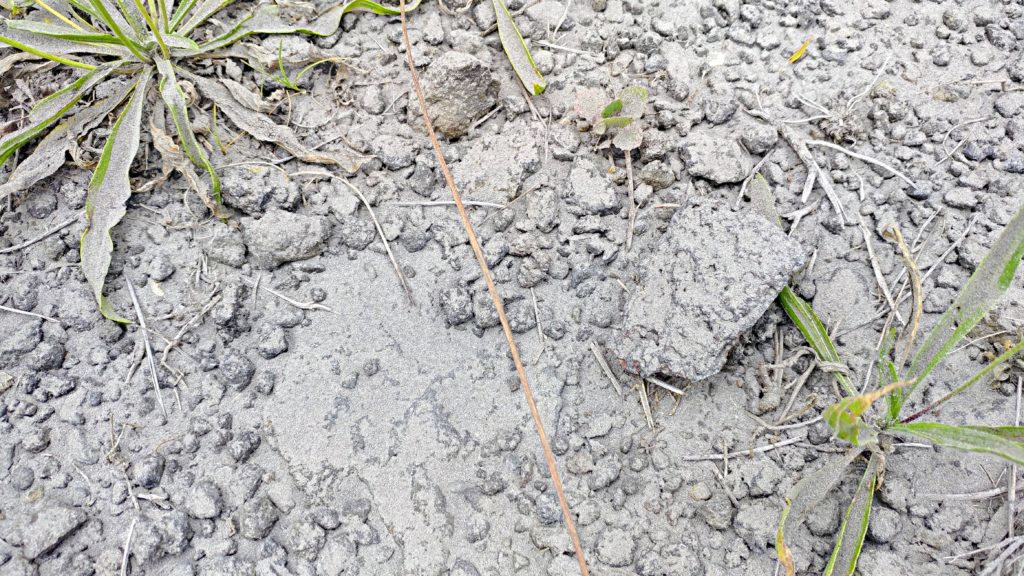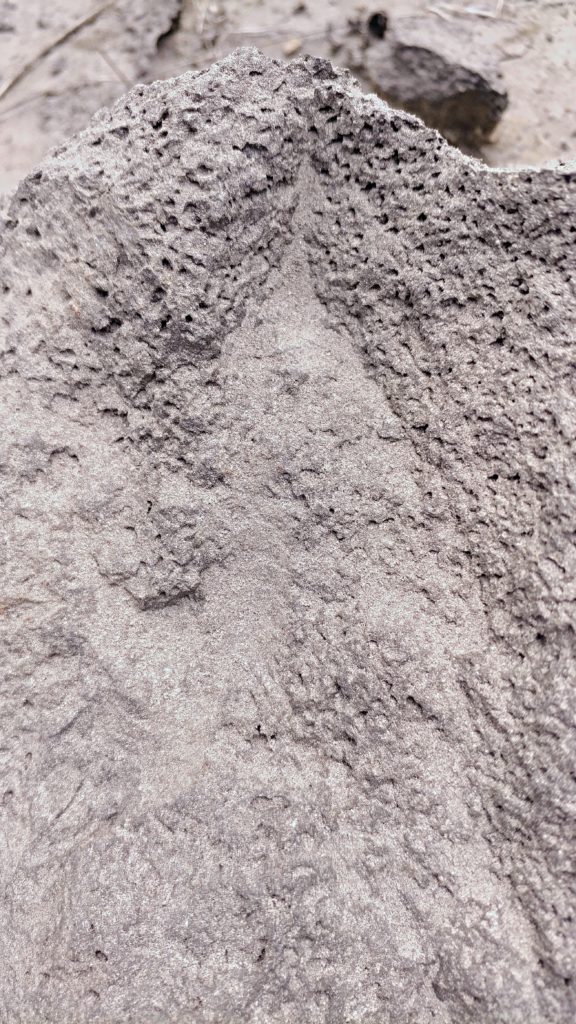SO2 & Ash Concerns Addressed at Ka‘ū Community Meeting

Ash covers much of the landscape downwind of the summit of Kilauea. This photo was taken by the passenger in a moving car from May 26, 2018. Vehicles are not allowed to stop within national park boundaries. PC: Scott Cate.
Emergency officials held a meeting in Ka‘ū to address the ash and amplified sulfur dioxide (SO2) levels in the are downwind of Halemaʻumaʻu Crater on May 30, 2018, at the Robert Herkes Gym and Emergency Shelter in Pahala.
“There is this new hazard of ash and this ongoing hazard of vog that has been amplified since this recent eruption,” said Wendy Stovall, a geologist and volcanologist with the US Geological Survey Hawaiian Volcano Observatory, referring the the latest eruption of Kīlauea Volcano, which began on May 3, 2018.
Stovall acknowledged there is a lack of generational knowledge about ash, but that the region has been dealing with SO2 for quite some time.
USGS HVO Scientist-in-Charge Tina Neal refers to this time as “unusual” due to the activity at both the summit and Lower East Rift Zone of Kīlauea.
The summit level has gone from a lava lake, to draining completely and now producing intermittent explosions expelling ash that impacts the community downwind.
The Lower East Rift Zone eruption is producing a lot of lava at the surface and a lot of gas.

Nearly constant explosions at the summit of Kīlauea cover areas downwind in ash on Highway 11 at the 45-mile marker on May 26, 2018 on Hawai‘i Island. PC: Crystal Richard
“That gas is also coming around the island at times and impacting your community here,” explained Neal.
Neal acknowledged that although communities in the area have been dealing with vog for 10 years, the ash is new.
Deanne Marks of the National Weather Service out of Hilo is working on ash fall advisories and modeling.
She explained to residents how the NWS monitors ash fall and SO2 using two daily weather balloon launches. The wind is profiled from the surface to 100,000 feet in the air.
“When we do have an explosion or SO2 moving around in the area, we can look at our wind profiles to see where exactly that’s going to move and what communities that will be affecting,” she explained.
She said another way the NWS is supporting efforts is by using its two weather radars—one in Kohala and one in South Point—to look for particulates in the air.
David Danby at USGS said scientists are working to collect and analyze the ash to see what danger it poses to the community.
Danby said they analyze what sort of impact the ash can have on the respiratory system and water supplies.
Danby said residents can help by collecting ash samples from clean surfaces and giving it to USGS to test.

Lava rock covered in ash from Halemaʻumaʻu Crater at the Summit of Kīlauea Volcano on Hawai‘i Island, May 26, 2018, on Highway 11 just outside the national park boundaries. PC: Crystal Richard
Dr. Liz Tam from O‘ahu spoke on how these hazards impact the lungs.
“If you look at volcanic air pollution, as long as you don’t get other things mixed up in it, like smog, tobacco smoke, its relatively pure,” said Dr. Tam.
Dr. Tam said they found that the acidity of the SO2 causes asthma sufferers to cough more.
Neal said new procedures are in place for notifying the community about the summit explosions and ash fall. New instruments are in place and they are working on better informing the community on conditions at the summit and air quality.
Fenix Grange of the Hawai‘i Department of Health acknowledged that the DOH made a mistake not notifying the public about the bad air quality in Oceanview and Kona areas on May 30, 2018.
“We did not do what we could have done, which is notify you, and I’m sorry,” said Grange.
When asked if there is a plan now, she said, “Yes, we do learn from our mistakes.”
Grange has been working on monitoring efforts and setting up new locations. She is working closely with Hawai‘i County Civil Defense.
A resident at the meeting addressed the concern from the community over the children of Ka‘ū being exposed to the poor quality of air while at school.
One resident described driving through the area an not being able to see the mac nut trees on either side of the road.
“My concern was why our school did not close down, and I don’t need a university degree to figure that out,” said the concerned resident.
She acknowledged the importance of everything going on in Lower Puna, but questioned why officials couldn’t make a trip to Ka‘ū one night to take a look at what is going on due to the summit activity.
“Our babies are being exposed,” she stated. “Common sense gonna tell you close the school down.”
Dr. Tam said, “I understand the concern and it can be very striking.”
She said in general, the ash is a nuisance. It falls on the skin, can clog up the nasal passages but ash doesn’t float down into your lungs.
“It will get your eyes but sometimes a school building will have more protection,” she explained. “Common sense is come inside.”
Dr. Tam recommends washing out the ash with water.
“Don’t play outside in the ash fall,” Dr Tam said, “But I don’t know that you need to close the school. I don’t know that but do not stay in the ash. The one good thing about it is it does not get down deep into the lungs.”
When a Ka‘ū teacher addressed concerns over caring for children during ash falls, it was recommended that during ash fall event,s children are kept inside. Shelter in place, freely breathing in an airtight room.
Earlier in the week Civil Defense Administrator Talmadge Magno said 18,000 N-95 masks were distributed to residents last week and 90,000 more masks this week.
Dr. Tam expressed concerns over children and elderly wearing masks and having them clog. N-95 masks do not protect against SO2 but do protect against ash, particles and Pele’s Hair.
The only adequate protection for children is keeping them in an air conditioned room.
Magno asked residents to sign up for the county’s Blackboard messaging for alerts.
He recommended keeping the radio on. He pointed out that KAPA radio (100.3 FM) might be the only radio station that reaches Ka‘ū (the Pacific Media Group station can be livestreamed through its website).
Magno said residents will have to adapt, shelter in place, or leave the area for some time.
Neal said that there were ash plumes being emitted almost constantly over the last few days. Residents can expect ash to continue to fall southwest of the summit area and once the winds die down, the summit region could see ash fall as well. Heightened seismic activity is expected to continue. Neal said that scientists are currently arguing over what is causing the explosions at the summit. She said it is likely a combination of three types of events: rock fall, gas charged explosions and water-involved explosions.
Ash continues to erupt intermittently from the vent within Halemaʻumaʻu Crater at Kīlauea’s Summit.
Additional explosive events that could produce minor amounts of ash fall downwind are possible at any time.
Earthquake activity is elevated at the summit, with a few felt events reported throughout the day.
Volcanic gas emissions at the summit remain high.
For forecasts of where ash would fall under forecast wind conditions, consult the Ash3D model output here.
Information on volcanic ash hazards and how to prepare for ash fall maybe found at http://www.ivhhn.org/information#ash (health impacts) or https://volcanoes.usgs.gov/volcanic_ash/ (other impacts).
Scientist are working an alert system for air quality.
For more information or questions, call (808) 981-5199.
Email questions to USGS HVO at [email protected]
Activity summaries are also available at 808) 967-8862.
Subscribe to volcano alerts online.
Related BIN Articles
Puna Community Briefed on Evacuations, Communications & Preparedness
UPDATE: Mayor Kim Announces Change in Emergency Procedure
















